

Dan Talks UI for VR at Develop 2015. Dan's talk is now available to watch: The hype around Virtual Reality is at astronomical levels - This year's E3 saw a number of VR titles announced as well as showcasing major developments in VR hardware from the likes of Oculus, Sony and Microsoft.
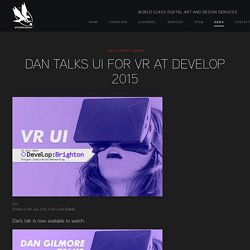
But as the industry embraces Virtual Reality, developing effective content for VR is still relatively new to many developers and creatives. Game UI Discoveries: What Players Want. Game UI Discoveries: What Players Want By Marcus Andrews [EA DICE designer Marcus Andrews examines the UIs of several recent games and picks apart what's required for both a novel and player-satisfying interface -- one that serves the needs of the game and its audience.]
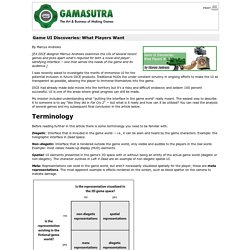
I was recently asked to investigate the merits of immersive UI for the potential inclusion in future DICE products. Traditional HUDs live under constant scrutiny in ongoing efforts to make the UI as transparent as possible, allowing the player to immerse themselves into the game. DICE had already made bold moves into the territory but it's a risky and difficult endeavor, and seldom 100 percent successful. My mission included understanding what "putting the interface in the game world" really meant. Before reading further in this article there is some terminology you need to be familiar with. Diegetic: Interface that is included in the game world -- i.e., it can be seen and heard by the game characters. Far Cry 2 What works?
Sixense. Oculus Rift - Virtual Reality Headset for 3D Gaming. Virtuix Omni. Virtual Reality Pioneer Looks Beyond Entertainment. Anyone who wants to learn how to use virtual reality to hack the human brain usually ends up visiting Jeremy Bailenson, founding director of the Virtual Human Interaction Lab at Stanford University.
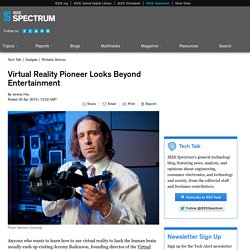
Bailenson has received visits from heads of state, the U.S. military and NASA during a career that spans almost two decades. But Bailenson recently observed that his VR lab’s technological capabilities are rapidly becoming obsolete as leading technology companies such as Oculus VR, Samsung, Google, Valve, Sony and Microsoft compete to develop virtual reality headsets that can entertain the masses.
The growing number of companies crowding into the virtual reality business doesn’t bother Bailenson. On the contrary, he’s thrilled by the recent surge of VR technological innovation that has allowed his lab to now replace its older $40,000 headset with a $350 Oculus Rift DK2 headset. TalkUX - UX in VR - UNIT9. The Real-Life Dangers of Augmented Reality. You know your cellphone can distract you and that you shouldn’t be texting or surfing the Web while walking down a crowded street or driving a car.
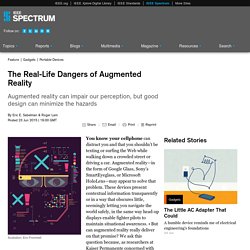
Augmented reality—in the form of Google Glass, Sony’s SmartEyeglass, or Microsoft HoloLens—may appear to solve that problem. These devices present contextual information transparently or in a way that obscures little, seemingly letting you navigate the world safely, in the same way head-up displays enable fighter pilots to maintain situational awareness. • But can augmented reality really deliver on that promise? We ask this question because, as researchers at Kaiser Permanente concerned with diseases that impair mobility (Sabelman) and with using technology to improve patient care (Lam), we see dangers looming. • With augmented-reality gear barely on the market, rigorous studies of its effects on vision and mobility have yet to be done.
There’s a simple way to fix this, of course. First consider the general ability to focus. Oculus Story Studio. Breadcrumbs - a first blog post By Max Planck Supervising Technical Director January 26th, 2015 A year ago, those of us at Oculus Story Studio were on different career paths working in computer animated films and story driven games.

Like most creators and artists who have seen modern virtual reality, we knew this emerging platform was not just a new gaming device, but a powerful new medium. Those of us story tellers venturing into VR sometimes feel like explorers cutting our way through a dense, overgrown, uncharted forest, and the deeper we get into the forest, the more profound of an experience we give our audience. Virtual Reality UX, Design, & Research · Twenty Milliseconds. UX & Virtual Reality - Designing for interfaces without Screens ~ UXness. Virtual Reality.
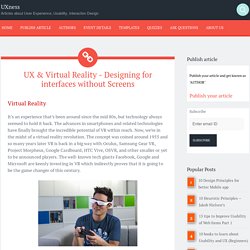
HY-C-2014-1.pdf. Cardboard Design Lab. Augmented Reality and a Better User Experience. After decades on the periphery, augmented reality finally appears poised to explode into the mainstream.

Consumers will soon be dazzled by products such as the much-hyped Google Glass, the FieldTrip app, and Oculus Rift, prompting many brands to explore this strange new world for the first time. Successful development still has its challenges, however. While Hollywood has given us some thrilling examples of the possibilities in films like Minority Report, Total Recall, and Iron Man, little substantive headway has been made in real life. Some cool work exists, but there’s been far more gratuitous AR eye candy with little utility or long-term usefulness. To alleviate some of the mystery, below are six key learnings for building AR apps that will help enhance user experience and improve end results. 1.
Not all apps and their use cases are created equal. “Public”—The whole body is involved, as are large screens and full movement of limbs and torso; think Nintendo Wii or Microsoft Kinect.